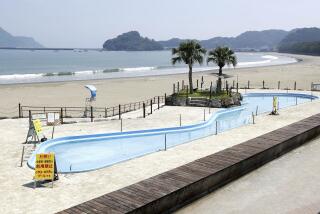Plan devised to stabilize crippled Japanese nuclear plant
- Share via
Reporting from Tokyo — The operator of the stricken Japanese nuclear power plant said Sunday that it hoped to stabilize the facility’s reactors by the beginning of next year in a state known as a cold shutdown.
The plan for the Fukushima Daiichi power plant is Tokyo Electric Power Co.’s most concrete timetable yet for resolving Japan’s worst nuclear crisis.
Emergency crews have struggled to avert a disastrous meltdown at the plant since March 11, when the earthquake and tsunami that struck the nation’s northeastern coast damaged the complex. Several explosions have rocked the plant, which has leaked dangerous radioactive isotopes into the air, soil and water. Workers have focused on trying to cool the reactors, but their plans have often seemed haphazardly conceived and executed and the results have been mixed.
“We are doing our best to avoid a deterioration of the situation,” said Tsunehisa Katsumata, Tepco’s chairman, bowing deeply and offering an apology during a news conference at the company’s Tokyo headquarters.
Last week, Japanese nuclear regulatory officials decided to raise the severity rating of the disaster at the power plant to the highest level by international standards, equaling the 1986 Chernobyl meltdown in the former Soviet Union. Before the rating was hiked, the disaster had been labeled on par with the 1979 Three Mile Island accident near Middletown, Pa.
Earlier Sunday, Secretary of State Hillary Rodham Clinton met with Japanese Foreign Minister Takeaki Matsumoto in Tokyo during a 5 1/2 -hour visit. Clinton, the highest-ranking U.S. official to travel to Japan since the disaster, said the United States had encouraged American corporate executives and tourists to “go about their normal lives and to travel to Japan.”
She said Washington and Tokyo had agreed to set up a “public-private partnership for reconstruction” that would involve both Japanese and U.S. companies and organizations.
Under the two-phase plan announced by the power company, the next three months will be spent cooling the reactors and plugging the leaks spewing radiation, Katsumata said.
During that period, workers will try to restore a cooling system for pools containing spent fuel rods and repair reactor No. 2, which is believed to have a hole in its containment chamber. Equipment will also be installed to decontaminate water that was used to cool the reactors and has been pooling in underground tunnels, at risk of spilling into the ocean.
In the second phase, Tepco hopes to bring the reactors to a stable shutdown state. If successful, the work would mark a significant step toward deactivating the reactors, which is expected to take years to complete.
Recently, Tepco has been under intensifying pressure from the government to explain to local officials and nearby residents how long it will take to gain control of the situation at the nuclear plant.
Tens of thousands of people have been living in emergency shelters since the government ordered residents living within 12 miles of the nuclear plant to evacuate. Many had complained about not knowing when it would be safe to go home.
Last week, Chief Cabinet Secretary Yukio Edano said the government would expand the evacuation zone after data showed higher than normal radiation levels in towns and villages outside the perimeter. The government had previously advised residents 12 to 18 miles away to stay indoors. About 200,000 people were living within 18 miles of the plant before the disaster.
On Sunday, Banri Kaieda, the minister of economy, trade and industry, said there was much to do before residents would be cleared to return home. “Tepco will have to thoroughly collect data on radioactivity levels, clean up contaminated soil and dispose of radioactive debris and water at the plant,” he said.
Some experts said that continuing aftershocks and typhoons during Japan’s storm season in August and September could delay work at the plant. “These kinds of natural disasters remain a worry over the next six to nine months,” Koji Okamoto, a professor at the University of Tokyo, told public broadcaster NHK.
Analysts estimate that Tepco will have to spend more than $100 billion to compensate residents and businesses near the plant in Fukushima prefecture. According to Japanese media reports, the government is considering helping Tepco with the payments by setting up a fund using loans from banks and payments from other power companies.
But Tepco’s Katsumata said nothing had been decided. “It all depends on the government’s support,” he said.
Japan is trying to rebuild after the magnitude 9 quake triggered a deadly tsunami that left tens of thousands homeless, mainly in the country’s northeast. More than 27,000 people are dead or missing.
Hall is a special correspondent.
More to Read
Sign up for Essential California
The most important California stories and recommendations in your inbox every morning.
You may occasionally receive promotional content from the Los Angeles Times.













